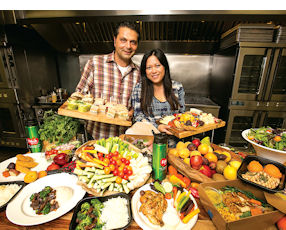Ham and cheese sandwich with a side of potato chips? That’s not on the menu for FreshLunches Inc. The Northridge company prepares and delivers gourmet meals at 35 schools in an area that stretches from the San Fernando Valley to over the hill. In addition to its Valley headquarters and kitchen, it opened a second kitchen last month in Culver City to serve new accounts on the Westside. Typical FreshLunches fare might be a chef’s special grilled salmon, a farmhouse salad with homemade dressing and a medley of white, purple, and orange carrots for kids to munch on. Its menu emphasizes farm-to-table ingredients and the freshness of its vegetables. The company’s main clients are small private schools such as the Archer School for Girls in West Los Angeles and Westmark School in Encino. “It’s something that a lot of parents needed and schools wanted,” said Alan Razzaghi, 43, who co-founded the company with his wife Uyen-Uyen Tong, 40, during a family vacation. While visiting Razzaghi’s sister and niece in San Diego seven years ago, the family started talking about the next day’s lunch plans around the dinner table. After hearing that his niece’s options for a school-provided lunch included tater tots and pizza, Razzaghi said he had a “light bulb” moment to create a catered lunch service with healthy food. He and his wife opened FreshLunches soon after and now serve an average of 15,000 to 20,000 meals a week, or about 70 meals per week at each school. It does not drop off meals for individual students whose schools are not clients. Meals, which parents or students can choose online, range in size and price. Small portions run $6.50 to 7.50 per meal, and large costs from $7.50 to $8.50. There’s also an athletic size designed for teenagers that costs $12 and up. Joe Pawlak, vice-president of Technomic Inc., a Chicago research and consulting firm specializing in the food service industry, said FreshLunches has tapped into a growing trend of serving local, fresh produce with no preservatives or oils – things he said parents are concerned about. But he added that given the price points, the strategy works best with wealthy customers focused on quality food – of which there are plenty in a $10 billion school food service industry. “The majority of consumer dollars spent in food away from home are coming from higher-level incomes. Those are the ones that are driving that,” he said. Lack of experience The business started in 2007, after four months of researching and planning brochures. Startup capital came from personal savings and credit cards, and amounted to $150,000 over two years. Razzaghi and Tong were ready to launch by the time the 2007-2008 school year started, while both of them were still working their full-time jobs. They rented a 150-square-foot kitchen to prepare the initial 35 meals they delivered during their work lunch breaks. The start was complicated by the fact that Tong was pregnant with the couple’s first child. “Every time we expand I have a baby, it’s bizarre,” said Tong, who now has two girls, a month-old and a four-year-old. Another one of the couple’s early challenges was their lack of experience in the food industry; Razzaghi had an engineering background while Tong’s background was in marketing and jewelry. The result was some mistakes. The couple then focused on research and talking to people in the industry to improve their product. “While a lot of our trial-and-error has been around packaging, temperature control and optimum flavor in our recipes, I do admit that we had some items which completely missed the mark, especially in the early days,” Razzaghi said. Some of the unpopular items included barley salad with avocado and turkey, as well as chicken wraps with non-fat plain yogurt on a wheat tortilla. Now, to get a better picture of what children will eat, the couple’s oldest child serves as a taste tester. The couple offer potential new client schools, parents and children a sampling of the company’s menu. If the schools agree to offer the service, FreshLunches reviews the kitchen facilities on site to determine whether the food will be prepared at the school or in its own commercial kitchens. Schools do not pay to have FreshLunches offered, but the price point can be a stumbling block for parents. Further expansion CHIME Institute’s Schwarzenegger Community School in Woodland Hills was one of FreshLunches first customers. Erin Studer, executive director of charter school programs for the CHIME Institute, said parents couldn’t afford the service. “Ultimately, we stopped the service with them because at the time, they didn’t offer the option that would allow us to provide free and reduced lunches because we are public school,” he said. Tong defended the prices, saying that they were reasonable given the product and selection. “They look beautiful with an amazing price point and they should be in every school,” she said. Razzaghi added that they reflect the company’s costs, which include trained servers who interact with students and know their name and preferences. In any case, the fresh produce approach has yielded some green in the bank. Revenue in 2012 totaled $2.1 million, and Razzaghi said the company is poised to have a projected growth between 30 and 40 percent for 2013. The couple would not disclose profits. The company was recently named No. 1,858 on the Inc. 5000 list of fastest-growing private companies, and is looking to further expand. It’s tiny kitchen? It’s now 3,500 square feet. “We love SoCal. We love to stay local. There is great access to locally grown food. We are looking to expand in Orange County and San Diego in the coming years,” Razzaghi said.
